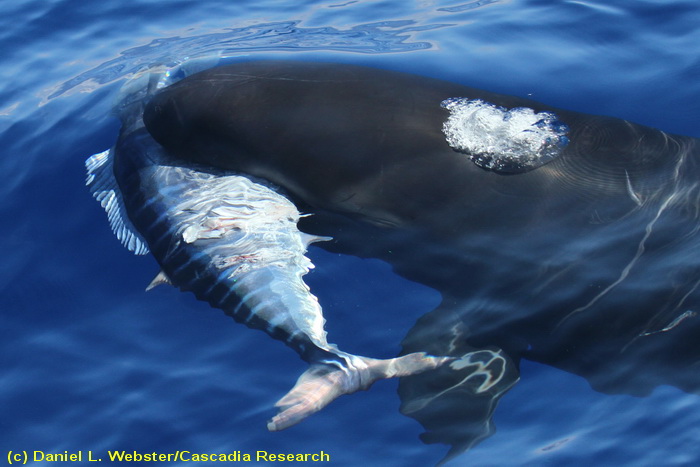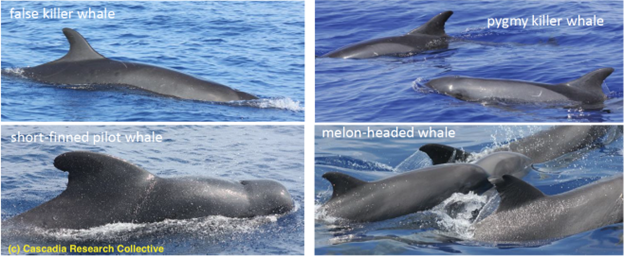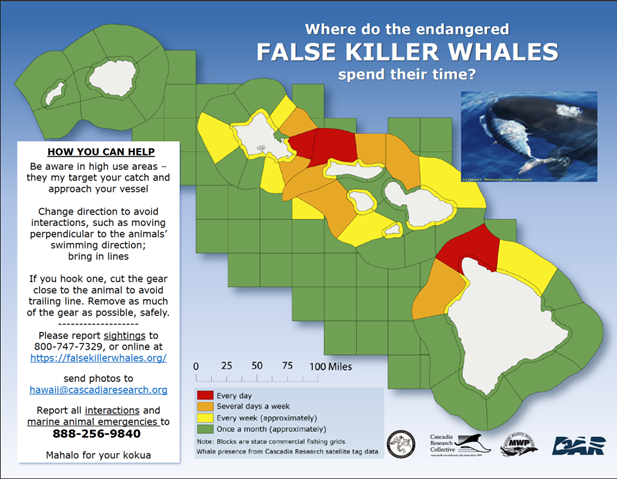10/16/23 – Protected Species Spotlight: False Killer Whales
By: Maya Goodoni,
DLNR DAR Protected Species Program
Meet the Species
Have you ever heard of a false killer whale? False killer whales (FKWs), or Pseudorca crassidens, are large-toothed whales that live in tropical and subtropical oceans. Given their name, you’d think they would resemble a killer whale. However, they do not resemble killer whales at all. FKWs are smaller and slimmer than killer whales and do not have white patches on their bodies. In 1846, scientists Richard Owen, John Edward Gray, and Johannes Theodor Reinhart found that the FKW skull highly resembled a killer whale’s skull, and thus gave this species its name: the “false killer whale.”
According to Dr. Robin Baird of Cascadia Research Collective, FKWs are very intelligent! False killer whales live in long-term, stable family groups like killer whales. They are also very social and share their catch with their family members. They actively forage, leap regularly, and often bowride.
Hawai‘i Populations
In 2017, NOAA Fisheries reported three distinct FKW populations in Hawaiian waters that do not breed with each other. There is a pelagic population, a Northwestern Hawaiian islands-associated population, and a main Hawaiian islands (MHI) population. The MHI population is the smallest, consisting of approximately 140 whales.

The MHI population is estimated to be half the size that it was in 1980. Aerial surveys undertaken from 1993 through 2003 by Joe Mobley of the University of Hawaiʻi West Oʻahu showed a steep decline in FKW sighting rates. Population surveys since the 1990s by Dr. Baird and colleagues indicate that the MHI population has continued to decline dramatically. In 2023, Dr. Janelle Badger of NOAA’s Pacific Island Fisheries Science Center, Dr. Baird and colleagues estimated the MHI population at 138 individuals, a decline of 5% per year. Due to its small population size, low reproductive rate, and continuing decline, the MHI “distinct population segment” was listed as Endangered under the Endangered Species Act in November 2012.
Diet and Foraging
FKWs are at the top of the food web in Hawaiʻi, and like most top predators, their population size is naturally smaller. According to Alison Stevens, predator populations are naturally lower because the prey populations need to be large enough to support the predator population. If predator populations are larger than prey populations, predators will eat all of the prey and then be without a food source.
FKWs hunt daily and eat larger pelagic game fish, including mahi-mahi, ono, aku, and ʻahi. According to NOAA Fisheries, they can dive for up to 18 minutes and catch prey up to 1000 meters deep.

It is a fantastic sight to witness FKWs hunting; they are known to throw their catch into the air before consumption. Like killer whales, they are also known to play with their catch before killing it. Since they prefer the same type of fish as humans, it creates competition between humans and FKWs. FKWs have been reported snatching fishermen’s fish off the hook or “depredating” their catch. In doing so, FKWs occasionally get hooked, which NOAA Fisheries considers one of the threats to the main Hawaiian Islands population.
Age and Reproduction
The oldest documented false killer whales were 63 years old for a female and 58 years old for a male. They have low reproduction rates with calving intervals of approximately seven years, which is one of the reasons why this population is so slow to recover when the population size is reduced. Unlike human gestation, which is nine months, FKWs’ gestation periods are 14-16 months. According to www.oceana.org, FKW babies are born about six feet long and will nurse for up to two years.
Identification
Three species of small black whales resident in Hawaiian waters look similar to the FKWs: the short-finned pilot whale (Globicephala macrorhynchus), the melon-headed whale (Peponocephala electra), and the pygmy killer whale (Feresa attenuata)

Above water, dorsal fin shots of the false killer whale, the pygmy killer whale, the short-finned pilot whale, and the melon-headed whale.
According to Dr. Baird, these whale species can be identified based on their dorsal fin size and position, head shape, and flipper shape. FKWs are approximately 5-17 feet and relatively large compared to the melon-headed whale and pygmy killer whale. Short-finned pilot whales have dorsal fins that are larger and further forward on the back than other species. Pygmy killer whales have rounded flippers and a rounded head when viewed from above. They also have a clear, distinct boundary beneath their dorsal fin. Melon-headed whales have pointed flippers and a pointed head when viewed from above. They have a very diffuse boundary beneath their dorsal fin, only visible under good lighting.
Main Threats
The primary threats to FKWs are the accumulation of pollutants and bycatch from commercial fishing. It is common for high-level predators like FKWs to accumulate high levels of pollutants in their bodies. The contaminants come from chemical runoff, such as agricultural pesticides, flame retardants, PCBs, and chemical detergents, which build up through the food chain. In 2009, Dr. Gina Ylitalo and her colleagues confirmed that MHI FKW had high levels of organic pollutants in their bodies by collecting and testing blubber samples. Some of these organic pollutants were at levels that could affect the animals’ health.
FKWs sometimes get entangled in fishing gear, and these whales are the most frequently bycaught species in the Hawaiʻi longline fishery. NOAA Fisheries estimates that 10-15 are killed or seriously injured yearly. Humans have also been reported shooting the whales to prevent them from eating their catch.
FKW Hotspots
The Cascadia Research Collective has tagged over 50 false killer whales and tracked them via satellite to discover where they aggregate. Results show that FKWs range across depths of 25 – 2,700 fathoms and concentrate off Oʻahu, Molokaʻi, Lānaʻi, and the north end of Hawaiʻi Island. These findings provide direction for where the most effective efforts should be focused to monitor and mitigate FKW bycatch.

Map showing the areas where tagged false killer whales were found to spend most of their time.
What You Can Do to Help
- Help conserve endangered FKWs by being aware of high cluster areas while fishing. If you see FKWs, consider moving locations to avoid interactions and bring in your lines.
- Help us identify and track the FKWs by calling the hotline (1-888-256-9840) to report sightings and interactions. Your contributions will contribute to the “hotspots” database.
- Take above-water photos of their dorsal fins and send them to [email protected].

We appreciate your participation in protecting this critical species!
For further reading, see the whales and dolphins page on the DAR website
References
Badger, J. L., D.S. Johnson, R. W. Baird, A. L. Bradford, M. A. Kratofil, S. D. Mahaffy, T. Cullins, J. J. Currie, S. H. Stack, and E. M. Oleson. 2023. Long term abundance and trends of the endangered stock main Hawaiian Islands insular false killer whales (Pseudorca crassidens). NOAA Fisheries Pacific Islands Fisheries Science Center, Honolulu, HI. 25 pp.
Baird, R.W., A.M. Gorgone, D.J. McSweeney, D.L. Webster, D.R. Salden, M.H. Deakos, A.D. Ligon, G.S. Schorr, J. Barlow, and S.D. Mahaffy. 2008. False killer whales (Pseudorca crassidens) around the main Hawaiian Islands: long-term site fidelity, inter-island movements, and association patterns. Marine Mammal Science 24:591-612. doi: 10.1111/j.1748-7692.2008.00200.x
Baird, R.W., S.D. Mahaffy, A.M. Gorgone, K.A. Beach, T. Cullins, D.J. McSweeney, D.S. Verbeck and D.L. Webster. 2017. Updated evidence of interactions between false killer whales and fisheries around the main Hawaiian Islands: assessment of mouthline and dorsal fin injuries. Document PSRG-2017-16 submitted to the Pacific Scientific Review Group.
Bradford, A.L., R.W. Baird, S.D. Mahaffy, A.M. Gorgone, D.J. McSweeney, T. Cullins, D.L. Webster, and A.N. Zerbini. 2018. Abundance Estimates for Management of Endangered False Killer Whales in the Main Hawaiian Islands. Endangered Species Research 36: 297-313. doi: 10.3354/esr00903
NOAA Fisheries. 2017. False killer whales: Sentinels of ocean health. https://www.fisheries.noaa.gov/feature-story/false-killer-whales-sentinels-ocean-health#:~:text=Genetically%20different%20from%20their%20long,maoli%20counterparts%20do%20on%20land. Accessed May 2023.
NOAA Fisheries. 2022. False killer whale. https://www.fisheries.noaa.gov/species/false-killer-whale Accessed May 2023.
Oceana. False Killer Whale. https://oceana.org/marine-life/false-killer-whale/ Accessed May 2023.
Stevens, A. 2010. Dynamics of Predation. Nature Education Knowledge. https://www.nature.com/scitable/knowledge/library/dynamics-of-predation-13229468/#:~:text=Predator%20and%20prey%20populations%20cycle,allows%20prey%20populations%20to%20rebound.
Sea Watch Foundation. Is it a porpoise? Is it an orca? No! It’s a false killer whale! https://www.seawatchfoundation.org.uk/is-it-a-porpoise-is-it-an-orca-no-its-a-false-killer-whale/ Accessed April 2023.
Ylitalo, G.M., R.W. Baird, G.K. Yanagida, D.L. Webster, S.J. Chivers, J.L. Bolton, G.S. Schorr and D.J. McSweeney. 2009. High levels of persistent organic pollutants measured in blubber of island-associated false killer whales (Pseudorca crassidens) around the main Hawaiian Islands. Marine Pollution Bulletin doi:10.1016/j.marpolbul.2009.08.029
